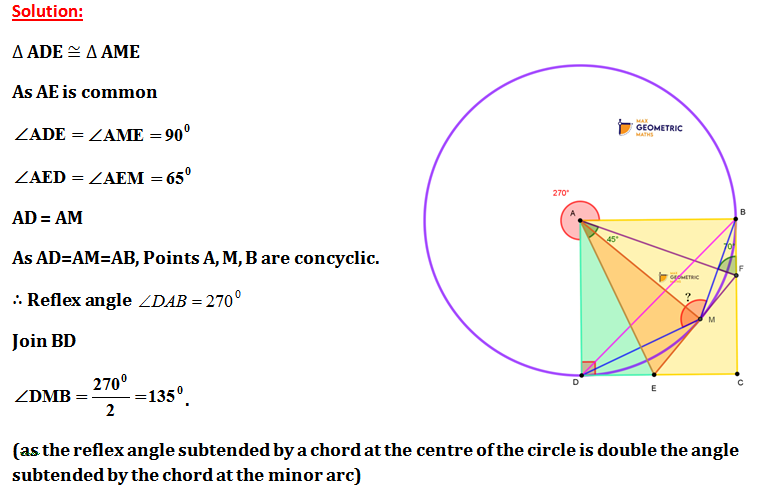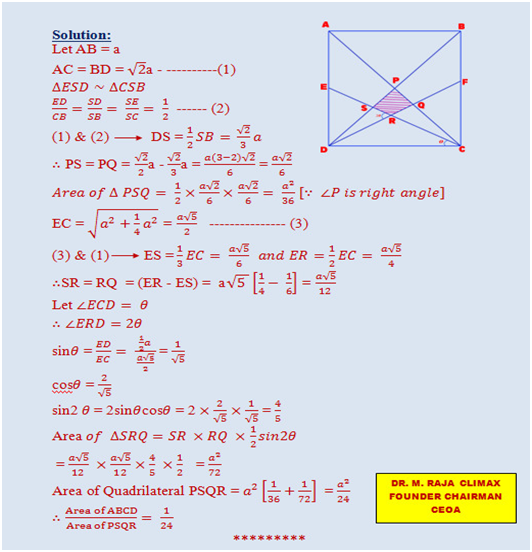Ordinary Quadrilaterals
A quadrilateral is a two dimensional shape having four vertices & four sides.
Quadri (four) + Latus (Side) = Quadrilateral (four Sided figure)
Also known as Quadrangle or Tetragon.
Sum of the interior angles = 3600

Area & Perimeter of the quadrilateral:
AREA
Area of the quadrilateral = ½ x diagonal x (sum of the perpendicular lengths
Area of the quadrilateral ABCD =(1/2) x 9 x (2+6) = 36 sq.cm
PERIMETER
Perimeter of the quadrilateral = sum of the sides of the quadrilateral.
Perimeter of the quadrilateral ABCD = 6 + 6 + 8 + 4 =24 cm

New Formula for finding the Area of a Quadrilateral:
Area of the quadrilateral = ½ x Product of diagonals x Sine of the angle between them.
Area of the quad ABCD = ½ x 9 x 8 x Sin 600
= ½ x 9 x 8 x (√3/2)
= 18 sq.cm
Note: If the angle between the diagonals is 30º, then the formula is more simple
Area of the quad ABCD = (Product of the diagonals)/4
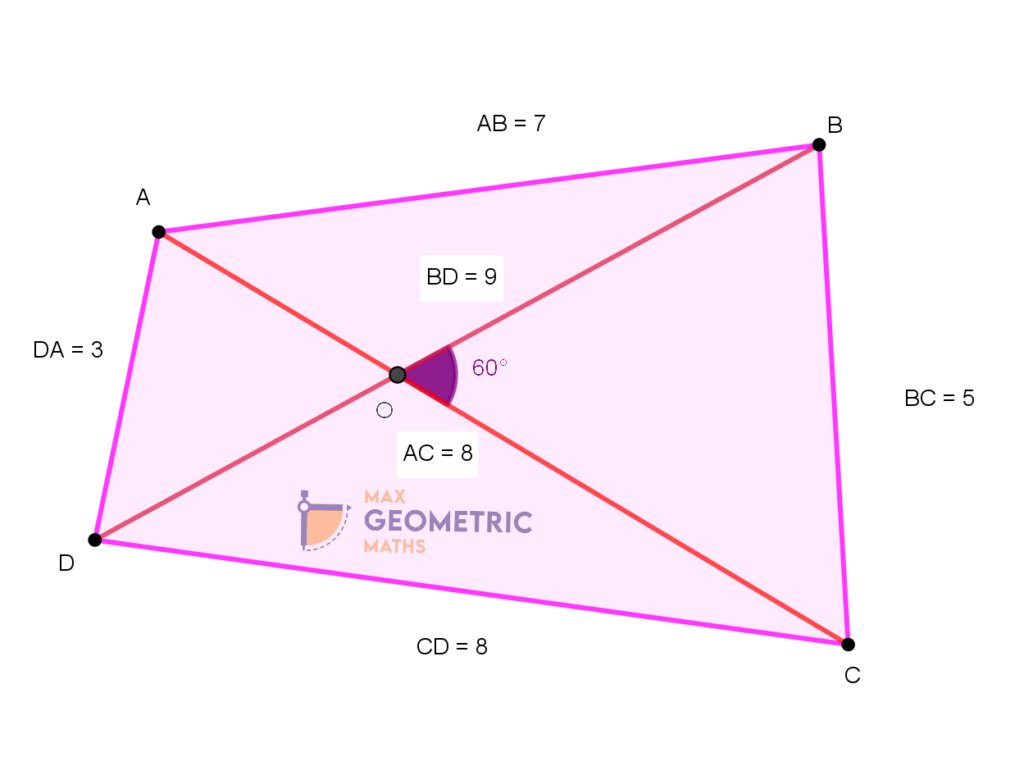
Quadrilaterals
Parallelogram

- 1. Opposites sides are equal & parallel
- 2. Opposite angles are equal
- 3. Consecutive angles are supplementary.
- 4. Diagonals that bisect each other.
Rectangle
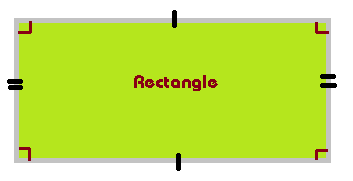
- 1. Opposites sides are equal & Parallel
- 2. All angles are equal to 90°
- 3. Diagonals are equal & bisect each other.
Trapezium

Only one pair of opposite sides is parallel.
Isosceles Trapezium
- 1. Only one pair of opposite sides is parallel.
- 2. Non-parallel sides are equal.
Square

- 1. All sides are equal.
- 2. All angles are equal to 90°
- 3. Opposites sides are Parallel
- 4. Diagonals are equal & bisect each other at right angles.
Rhombus

- 1. All sides are equal.
- 2. Opposites sides are Parallel
- 3. Opposite angles are equal
- 4. Diagonals bisect each other at right angles.
Kite

- 1. Two pairs of adjacent sides are equal.
- 2. One pair of opposite angles (that are obtuse) are equal
- 3. Diagonals are perpendicular to each other
- 4. The longer diagonal bisects the shorter diagonal.
| Quadrilaterals | Dimensions | Area | Perimeter |
|---|---|---|---|
Parallelogram |
Breadth = b |
b x h |
2 (a + b) |
Rectangle |
|
l x b |
2 ( l + b) |
Square |
Side = a |
a2 |
4a |
Rhombus |
Length of the diagonals = d1 , d2 |
½ x d1 x d2 |
4a |
Trapezium |
Length of Parallel Sides = a, b. |
½ x ( a + b) x h |
Sum of all sides |
Kite |
Length of the diagonals
= d1, d2
|
½ x d1 x d2 |
2 (a +b) |
Theorems
Theorem # 1

Theorem # 2

Theorem # 3

Cyclic Quadrilaterals
A quadrilateral is called Cyclic quadrilateral if its all vertices lie on the circumference of a circle.
If ABCD is a cyclic quadrilateral, then the points A,B,C,D are called as concyclic points.
Theorem # 1

Theorem # 2

Theorem # 3

Theorem # 4

Theorem # 5

Theorem # 6
1. For a parallelogram to be cyclic or inscribed in a circle, the opposite angles of that parallelogram should be supplementary.2. A cyclic square/rectangle can be formed by taking the centre as the point of intersection of diagonals.
Theorem # 7

Hence, Points A, B, C, D are concyclic.
Theorem # 8
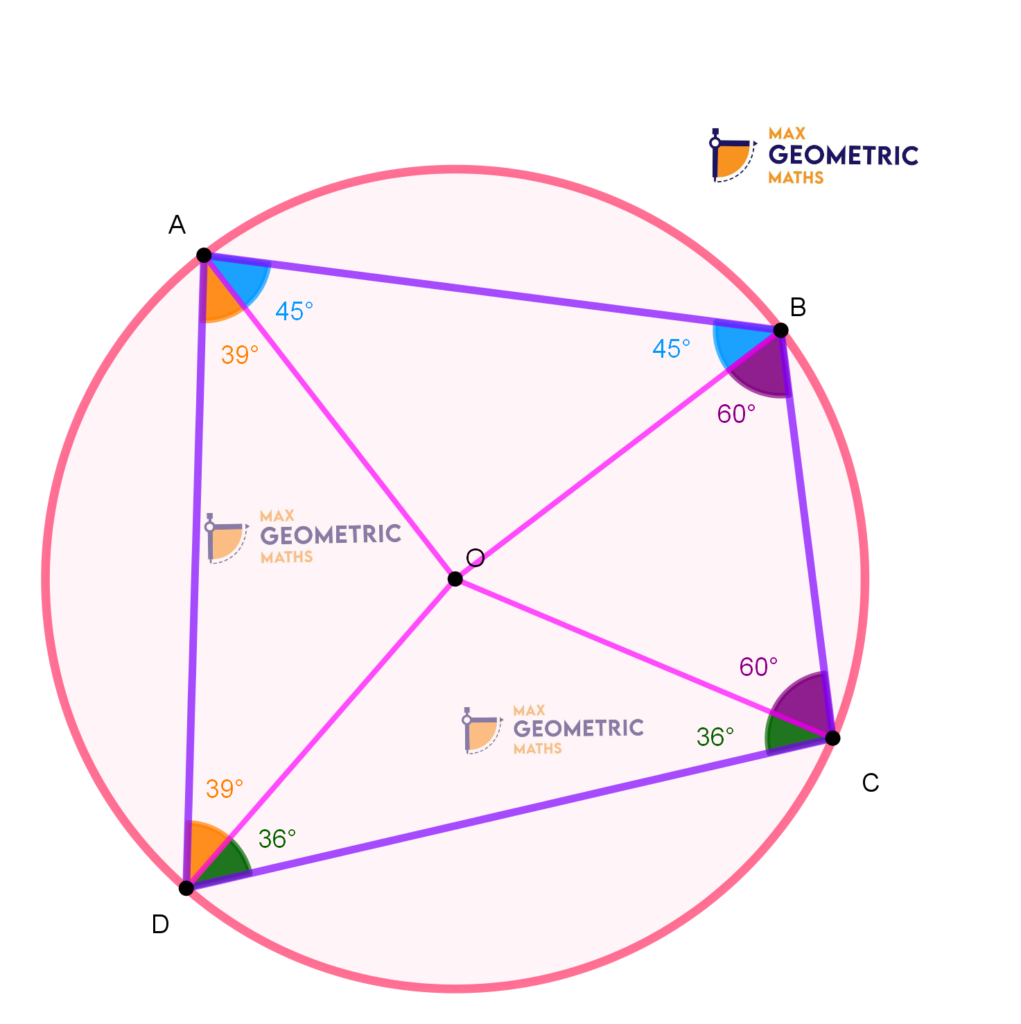
Ptolemy’s Theorem
The product of the diagonals is equal to the sum of the product of its two pairs of opposite sides.
If ABCD is a cyclic quadrilateral with AC & BD as diagonals, then (AB x CD) + ( BC x AD) = AC x BD

AC x BD = 11x10 = 110
(AB x CD) + (BC x AD)= (8 x 5) + (7 x 10) = 110
Brahmagupta Formula
(for finding Area of Cyclic Quadrilateral
Ifa, b, cand dare the sides of a cyclic quadrilateral, then its area is given by:

Where s is the semi perimeter s = 1/2(a+b+c+d)
Diagonals of Cyclic Quadrilaterals
Suppose a, b, c and d are the sides of a cyclic quadrilateral and di & d2 are the diagonals, then we can find the diagonals of it using the below given formulas:

Radius of Cyclic Quadrilateral
(for finding Area of Cyclic Quadrilateral
Ifa, b, cand dare the sides of a cyclic quadrilateral, then its area is given by:

Where s is the semi perimeter s = 1/2(a+b+c+d)
Brahmagupta’s theorem
In a cyclic quadrilateral if the diagonals intersect each other at right angles, then the perpendicular to a side from the point of intersection of the diagonals always bisects the opposite side.

Author’s Creation in Quadrilaterals
1. Question:
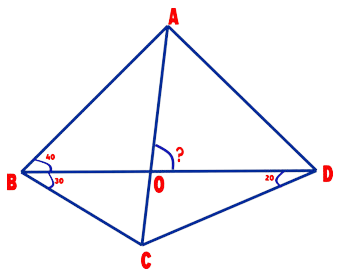
In quadrilateral ABCD, AC & BD meet at O; AB = AD; ∠ABD = 40°; ∠CBD = 30°; and ∠BDC = 20°. Find the measurement of ∠AOD.
Question created by
Dr.M.Raja Climax
Founder Chairman, CEOA
2. Question:

ABCD is a square. E & F are points on AB & BC respectively such that ∠EDF=45º. Prove that ED & FD are the bisectors of ∠AEF & ∠CFE
3. Question:

ABCD is a square. E & F are points on DC& BD respectively such that ∠EAF =45°& ∠AFB =70° as shown in the figure. Ifa perpendicular is drawn from Ato EF meeting EF at M, then find ∠DMB
4. Question:

Research done by
Dr.M.Raja Climax
Prof G. LAKSHMANA MURTHY.
5. Question:

In the above figure, ‘O’ is the orthocentre of Δ ABC. Identify & write the cyclic quadrilaterals figuring inside ΔABC.
6. Question:

Modified Rider :
The diagonals AC and BD of a cyclic quadrilateral ABCD intersect at P. Let O be the centroid of ∆APB and H be the orthocentre of ∆CPD. Show that the points H,P,O are collinear.
7. Question:

ABCD is a Cyclic quadrilateral with AB = AD and CB = CD. M and N are points on AB and AD respectively such that ∠MCN = ∠ABD. Prove that MN = MB + ND.
8. Question:

Given a quadrilateral ABCD where BD bisects ∠B , P is a point on BC such that PD bisects ∠APC. Show that ∠BDP + ∠PAD = 90°
Click here to view the problem in GeoGebra.
https://www.geogebra.org/m/yanv3fgjAuthor’s Solution for Challenging Problems in Quadrilaterals
1. Question:
ABCD is a quadrilateral. Its diagonals AC & BD measuring 6 cm & 5 cm respectively cut each other at O and ∠AOD is 30°. Find the area of the quadrilateral ABCD.
Question created by
Dr.M.Raja Climax
Founder Chairman, CEOA
2. Question:
Find the value of θ, if ∠PAB = ∠ PBA = 15º

The question sender was taken aback on viewing two simple solutions for such a challenging problem.
3. Question:
Find tanθ in the given figure

4. Question:

P is a point on side AB of square ABCD such that DP =5cm. DQ is the angle bisector of ∠PDC where Q is a point on side BC. Then find the length of (CQ+AP)
5. Question:

If ABCD is a square with side 5 cm, E, F, G are the midpoints of the sides AB, BC, CD respectively. Find the area of the shaded region
6. Question:
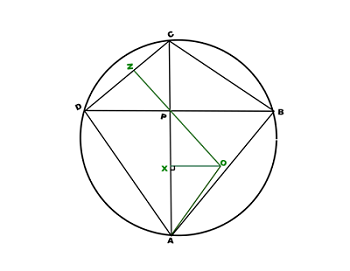
ABCD is a cyclic quadrilateral. AC & BD meet at P. O is the circumcentre of ∆ APB. Prove that, PZ is an altitude of ∆ CPD and there by prove that O, P and the orthocentre of ∆CPD are collinear,
7. Question:

In the square ABCD, E is the interior point such that ∠AED is 90º. F is point on DE such that ∠CFD is 90º. AF meets CD at G. CE meets DA at H. Lines GH and CF meets at N, GH and AE meet at M. Then prove that GN=HM
8. Question:

ABCD is a square. E & F are mid-points of sides AD & BC respectively. Line segments AC,BD,CE & DF intersect in the interior of the square to form a quadrilateral PQRS as shown in the figure. What is the ratio of area PQRS to that of ABCD?




